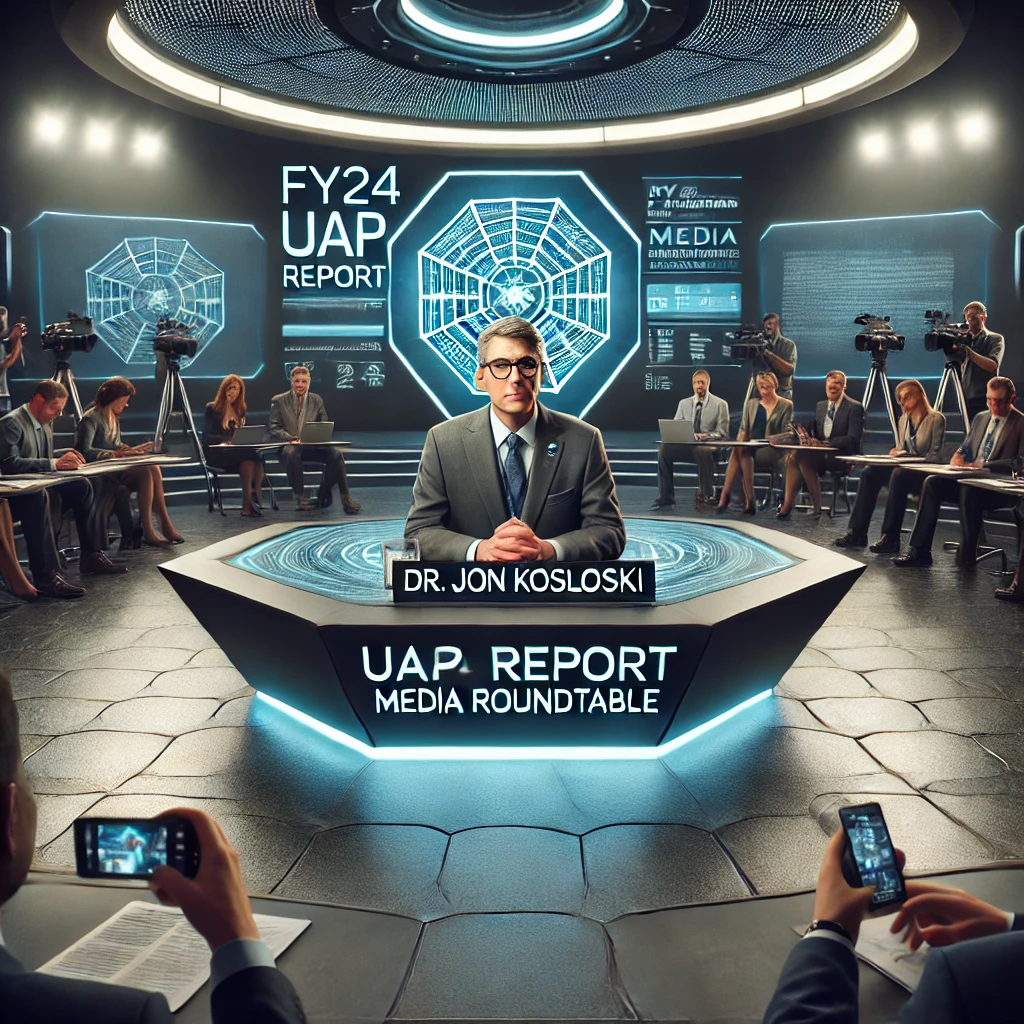Dr. Jon Kosloski: AARO Media Roundtable on FY24 UAP Report

On November 14, 2024, Dr. Jon Kosloski, the newly appointed Director of the All-domain Anomaly Resolution Office (AARO), held his first media roundtable with the Pentagon press corps to discuss the release of AARO’s Fiscal Year 2024 Annual Report on Unidentified Anomalous Phenomena (UAP). Dr. Kosloski, who took over as director in August after a distinguished career at the National Security Agency specializing in advanced optics, computing, and cryptographic mathematics, described his deep interest in tackling complex scientific challenges, which he sees as central to AARO’s mission.
The report revealed that AARO has cataloged over 1,600 UAP cases, with 757 new reports submitted during the reporting period. While hundreds of these cases were identified as mundane objects like balloons, drones, birds, or satellites, approximately 900 lacked sufficient scientific data for proper analysis and have been retained in an “active archive.” These cases remain open and could be revisited if new information becomes available. Dr. Kosloski highlighted that less than 3.5% of all cases exhibit truly anomalous characteristics, which could suggest advanced or breakthrough technology.
During the briefing, Dr. Kosloski emphasized AARO’s commitment to reducing bias in UAP reporting, noting the concentration of sightings near U.S. military installations and sensors. He acknowledged efforts to counter this bias through increased commercial pilot reporting and the deployment of the experimental “Gremlin” system at an undisclosed national security site. The 90-day trial is intended to establish a baseline of “normal” aerial activity and improve AARO’s ability to discern true anomalies.
In addressing public concerns about government transparency (UAP: Exposing the Truth), Dr. Kosloski admitted the difficulties of handling classified data from sensitive intelligence sources but detailed efforts to expedite the declassification process. AARO has hired declassification experts and plans to release a selection of resolved cases, complete with video evidence, on November 19, 2024. Additionally, AARO is preparing a second volume of its congressionally mandated Historical Record Report, which will revisit notable cases like the Phoenix Lights. He noted that data limitations, including the destruction of archival film, have hindered investigations into many historical incidents.
Dr. Kosloski also outlined plans to expand AARO’s reach, particularly through increased international cooperation. Beginning in 2025, the office aims to establish partnerships with traditional U.S. allies (Five Eyes) and broaden its engagement with foreign governments. While no evidence has been found linking UAP activity to foreign adversaries, Dr. Kosloski acknowledged the potential risk of adversaries exploiting the stigma surrounding UAPs to evade detection.
In the discussion, Dr. Kosloski shed light on intriguing unresolved cases that span a variety of morphologies, including orbs, cylinders, and triangles. While none of these cases have provided evidence of extraterrestrial origin or advanced capabilities, he admitted that some defy explanation even with his extensive scientific background. He emphasized that AARO remains open to academic collaboration to explore these phenomena, recognizing the limits of government expertise in addressing unprecedented technological possibilities.
Dr. Kosloski reiterated AARO’s commitment to following the data and science wherever they lead, while maintaining transparency with the public as much as security constraints allow. He characterized AARO’s mission as one of rigorous inquiry into one of the most perplexing and potentially significant scientific challenges of our time, emphasizing the importance of a methodical and collaborative approach.
Dr. Jon T. Kosloski is a distinguished scientist specializing in quantum optics and cryptographic mathematics. He earned bachelor’s degrees in Mathematics and Physics from California State University, San Bernardino, and a Ph.D. in Electrical Engineering from Johns Hopkins University, where his doctoral research focused on developing novel devices utilizing quantum optics principles to detect weak phase-encoded signals. At the National Security Agency (NSA), Dr. Kosloski held technical and leadership roles within the Research Directorate, leading advanced mission-oriented research in networking and computing. He also served as a subject matter expert in Free Space Optics, advising various Department of Defense agencies, and invented an advanced language-agnostic search engine. In August 2024, he was appointed Director of the All-domain Anomaly Resolution Office (AARO), where he oversees efforts to investigate and explain unidentified anomalous phenomena.


